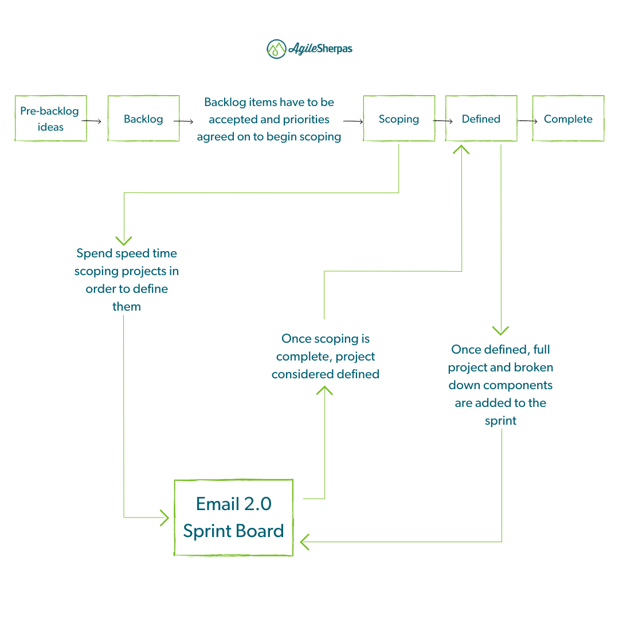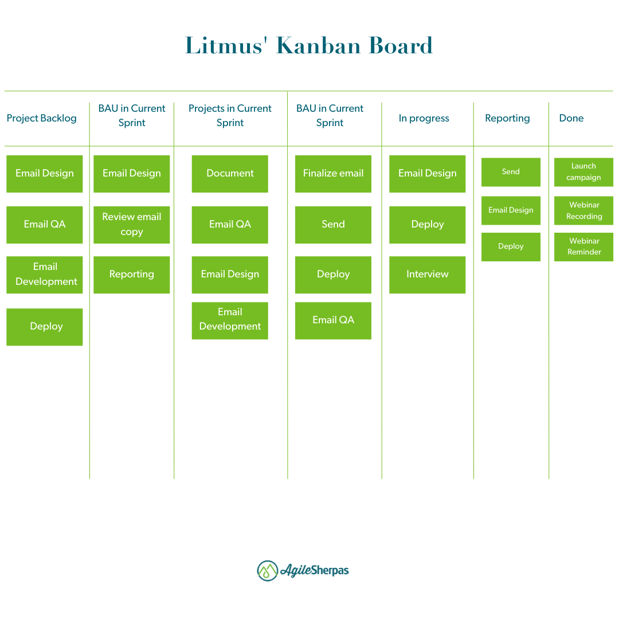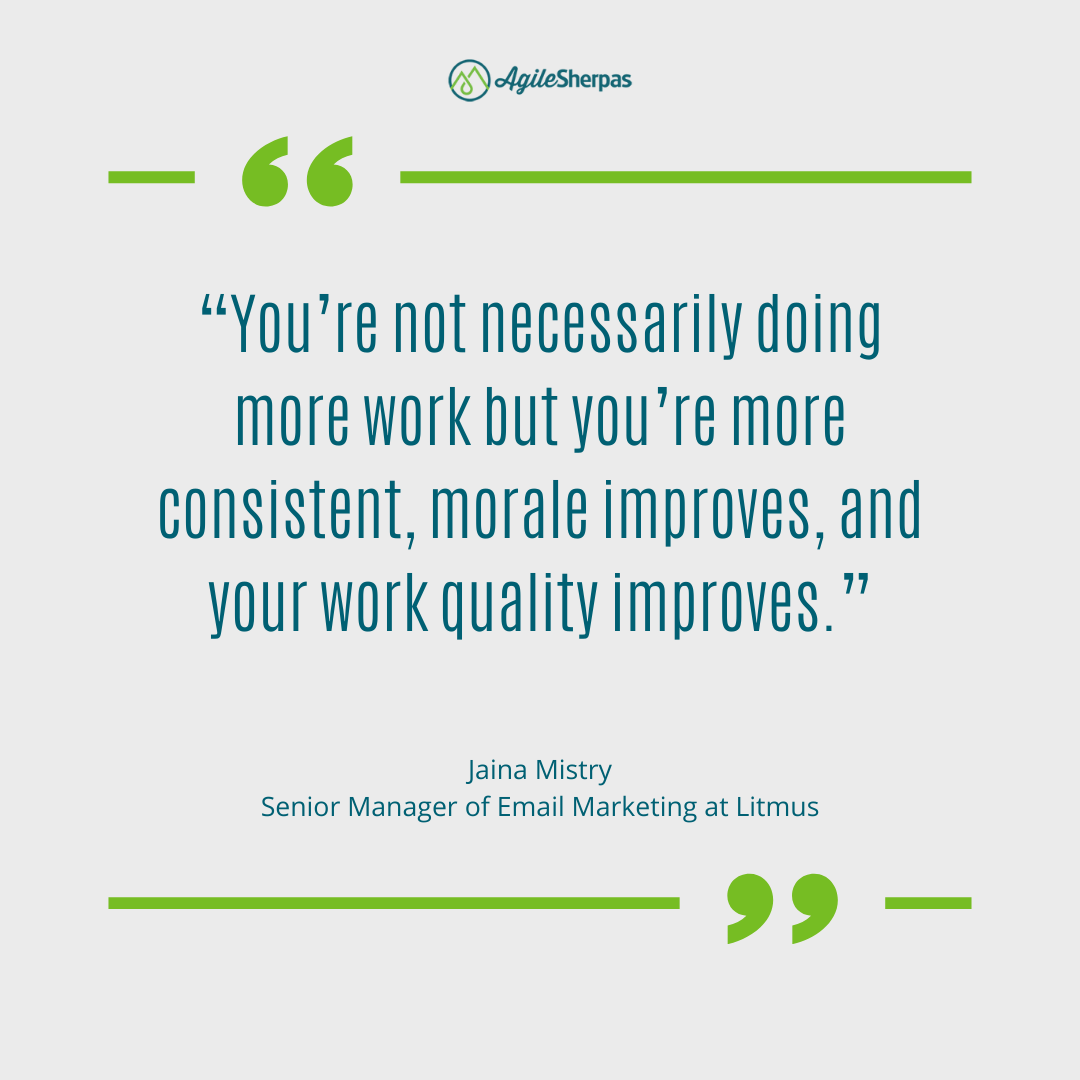Improve your Marketing Ops every week
Subscribe to our blog to get insights sent directly to your inbox.
Confront your process problems head on with a Sherpa by your side.
Explore support options that are tailored to meet you wherever you are on your climb.
Browse our pioneering Agile marketing courses
Learn from the stories of marketers already on the road to process improvement.
Featured Resource

State of Agile Marketing
Learn from 8 years of study on how marketers are increasing their agility.
Download Report
Email marketing is a fantastic place to start implementing Agile ways of working. Testing ideas, iterating, and really diving deeper into understanding your stakeholders all work particularly well in this area. But figuring out how to translate the Agile principles you may have read about into an actual plan of action often isn’t as easy as it initially seems.
To get to the actual value Agile email marketing has to offer (and we promise, there’s a lot to be had) you need to start with an understanding of the fundamentals. Then, we’ll have a look at the experience of Litmus to see what applying these principles looks like in practice. This will enable you to learn some of the tougher lessons without needing to make the same mistakes.
Agile email marketing is all about applying the principles of Agile marketing towards more effective email campaigns. That means focusing more on understanding your stakeholders to ensure your email campaigns deliver the value they need. It’s also about ensuring your email marketing is sustainable so you can deliver that value in the long term.
In practice, this often means breaking work into smaller pieces to enable your marketers to pivot more quickly and implement learnings. For example, avoiding spending huge amounts of time planning big and complex campaigns or sequences only to discover they’re not working after all that investment. Instead, breaking that campaign into smaller pieces that can be tested individually before implementing those learnings enables you to learn and iterate far faster.
Taken together, this focus on stakeholders, constant improvement, and more adaptive campaigns all enable Agile email marketing to deliver better results than its traditional counterparts. But don’t take our word for it, Litmus experienced that very thing.
An important thing to understand about Agile email marketing is that it’s never one-size-fits-all. The way you implement it should always be based on your specific needs and circumstances. That’s why it’s useful to see how real organizations have done just that: translating Agile theory into practice to get real results.
That’s why, whenever possible, we try to speak with marketers of all kinds who have implemented Agile to learn from their experiences. We recently jumped on a call with Jaina Mistry, Senior Manager of Email Marketing at Litmus. As an all-in-one email marketing tool, they know the challenges and opportunities of great email marketing better than just about anyone.
Jaina has worked at Litmus for five and a half years, and in email marketing for over 15. During that time, she’s done everything from email design development and email strategies, to running the email program at Litmus.
Today, every email Litmus sends, from newsletters to onboarding, is touched by the three-person team of her, an email marketing specialist, and an email designer.
But how did this small team end up transitioning to Agile?
It all began when Jaina and Litmus’ Senior Vice President of Marketing took the Agile Marketing Fundamentals course from AgileSherpas. Following that course, they decided to implement a pilot program. The challenge was deciding which area of the marketing team would be ideal for such a pilot.
They reasoned that because the broader marketing team had so many moving parts and was very connected to the rest of the company, it made sense to run the pilot in the email marketing team. They were fairly compact and already used some Agile processes; the transition would be less disruptive for them.
So, over the course of December 2021 and January 2022, Jaina put together an Agile workflow for her team.
In particular, she focused on integrating an iterative approach, because her team was used to “big bang” projects. In these projects, someone would come to their team wanting to, for example, rework a nurture campaign. Jaina would then break this down into the steps needed to complete the task.

Now, they try to place the customer at the center of their process, breaking it down into more manageable and achievable steps. The result is that big projects don’t feel as big and intimidating.
One major question other people considering Agile email marketing have is what Jaina and her team would do differently based on their first few months working with Agile.
The first and largest thing Jaina brought up was simple:
“I wish we had done it sooner.”
She recognizes they simply didn’t have the time to change their processes before, but seeing the early results still makes her wonder why they waited so long.
The second thing which came to mind was making changes too quickly within Agile. Currently, the email marketing team has sprint retros every two weeks, and each time they have been identifying processes to change.
While this kind of adaptation is a core tenant of Agile, she does have some concerns that it’s causing them to start each sprint “from a base level.”
For the team, this meant that process changes made it feel like they were starting a new process from scratch with each sprint instead of making tweaks. Obviously this makes it difficult to get used to Agile and start improving efficiency.
Jaina pointed out that every team has to find the right balance between making such changes and simply getting better at the processes they already have.
Before proceeding to learn the main takeaways & advice, why don't you take a second to get our Agile Marketing Transformation Checklist?
Aside from what the Litmus team would do differently, Jaina wanted to share other key takeaways from their Agile email marketing experiences so far.
Jaina realized that she needed to really flesh out this entire process: what she wanted to get out of Agile, the goals, benefits, etc. This helped her decide on a hybrid approach to Agile.
To get an idea of what this should look like, she began mapping the team’s rules, definitions, etc. Afterwards, she began setting things up in Asana.

But that’s where an issue arose.
She quickly realized that she would need to change some rules and definitions she was planning on using. Because her team worked with the rest of the marketing department, they had to be sure their terms would be understood by their colleagues (a challenge faced by many Agile marketing pilot teams).
In fact, before Agile, various teams in the marketing department each used Asana in a slightly different way.
For example, one team might define “due date” as the day when something should be 100% completed, while another team might think of it as the date when they should begin a task. All of these competing definitions created unnecessary friction, delays, and many other problems that culminated in a lack of clarity.
So the email term set rules like “no two items in the backlog can have the same priority,” and specified that the backlog should list items that are on the task level.
They also ensured that all items would be scoped and defined the same way. Having these rules spelled out in a single document everyone had access to helped improve communication and workflow.
Jaina also came to immediately appreciate Agile's emphasis on visibility. Even in their three-person team, allowing each member to see what’s coming up, what’s blocking people, and what’s in their backlog has made a world of difference.
Agile has markedly improved the level of communication and visibility within her team.
Previously, the email marketing team had a weekly hour long meeting they used for project updates. Now that they get their updates via quick daily standups, that meeting has transformed into time used for ideation, brainstorming, and other useful things that are otherwise difficult to achieve in a fully remote team.
“You’re not necessarily doing more work, but you’re more consistent, morale improves, and your work quality improves,” Jaina says.

“I found the AgileSherpas blog very useful!”
There are so many different resources that help you understand the whys and hows of Agile email marketing before you really dive in. Jaina pointed out that many people tend to obsess over tools, arguing that you have to use X tool in Agile.
But she opted to use a tool they were already using (Asana) and felt that was the right choice to ensure her team remained integrated into the larger marketing team. It also means that expanding the use of Agile in the team will be easier down-the-line.
Jaina put it simply: “communication and visibility are two things you can’t do too much with Agile.”
She emphasized the need for daily standups and generally focusing on ensuring your processes are up-to-date, often telling her team to move something to this column when it’s done, leave comments, etc.
In other words, you need to be extra vigilant about these things, especially early on when you’re establishing good Agile practices.
Jaina’s team had marketing leadership’s buy-in from the beginning, because Litmus leadership wanted the marketing team to become far more efficient. She emphasized how vital that buy-in was; without their support there’s no way Jaina and her team would have been able to make the necessary changes.
A common mistake teams make when trying Agile is pursuing it for its own sake. Unfortunately, the circular logic of “we’re trying to be Agile so we can be Agile” isn’t very useful or inspiring. Instead, if you build your adoption of Agile email marketing around achieving specific goals like better responsiveness or increased experimentation.
This will help focus your efforts so you can progress through the other steps in a way that optimizes for your ultimate goals. Here’s how Jaina put it:
“If you’re thinking about starting Agile, stop thinking about it and start putting a plan together: start with pain points and then use AgileSherpas resources to understand how Agile can help you solve those pain points. The thing with Agile marketing is that every team is doing it differently so you need to learn and adapt.”
Implementing Agile marketing in any capacity really requires getting people on board to work. That means both the relevant senior people who will need to authorize the resources and the team members themselves. This can come through training, or just gradual conversations from an internal Agile champion. What you want to avoid is making Agile feel like something dictated from above.
A part of building internal support is getting the training you need to understand Agile email marketing. Then, coaching can help you adapt those learnings to your real-world challenges. Just be sure you balance the training you get without relying too much on things like formal training or e-learning alone.
Once you have a firm understanding of your goals and have built internal support for Agile you can identify the framework that works best for you. Typically this will be the more prescriptive Scrum, the continuous delivery focused Kanban, or a hybrid of the two. Your choice may be based on what other Agile teams in your organization are using or simply on your own team’s needs.
Now it’s time to start trying Agile email marketing for yourself. Importantly, even after completing all of these other steps, you’re never 100% “finished” implementing Agile email marketing. One of the core reasons adaptability and evolution are built into Agile ways of working is the understanding that marketing never stays the same. Ensure you have processes in place to regularly review how things are going and experiment with improvements. This culture of continuous improvement will help ensure your Agile email marketing never gets stale!
Fortunately, AgileSherpas has a variety of resources to get you started on your path towards effective Agile email marketing. Check out our wide variety of resources to find the right courses, certifications, or coaching for your needs.
Address potential obstacles marketers might face when transitioning to agile email marketing and offer practical solutions to overcome them. To maintain the flow of the content related to Litmus, reference their challenges and solutions as well there.
This situation usually stems from making any number of common Agile implementation mistakes. The challenge is that while Agile is extremely flexible, that flexibility can lead to teams undermining its core tenants and therefore the value Agile provides. The best thing to do here is talk with a seasoned Agile marketing coach or consultant who can help you understand what might be going wrong.
For all its flexibility, Agile is an all or nothing proposition. A team can't be Agile part-time without ending up undermining the benefits and asking the first question on this list. That said, it is possible to have a fully Agile email marketing team within a non-Agile marketing function. But you’ll get more benefits and have an easier time if the entire function can transition to Agile ways of working.
One of the most important things to understand about Agile email marketing is that, unlike many other email marketing strategies, it doesn’t prescribe one way of doing things. It’s more about the processes behind things like choosing subject lines. This means you can easily combine it with common strategies like Show Me You Know Me.
This question really comes down to a few things. First, if there’s a framework the rest of your function or organization uses, it will probably be easier to collaborate with them by using the same one. Otherwise, it really comes down to how you structure your work.
Do you run email marketing campaigns that run for short intervals or do you manage several bigger “always on” campaigns? For the former, Scrum can work well, but in most cases, Kanban, or a hybrid approach is ideal because they don’t require work to be fully completed in a set period of time.
Litmus itself runs various events, maintains a community, and has a variety of courses you can use to improve your skills. For more general tips and inspiration around Agile marketing we can recommend subscribing to the Agile Sherpas Newsletter.
You can also check out our more general Agile marketing FAQs to see more questions you may have answered.
Ask any veteran of the email marketing world and they’ll tell you that nothing stays the same for long. Customer behaviors and expectations, legal regulations, spam rules, etc. are all constantly evolving. That’s why Agile email marketing is built around constantly adapting to those changes so your emails remain relevant and impactful.
If you’re ready to dive into email marketing head first, you can learn all the skills and concepts you need in our self-paced digital course platform The Ropes. It’s a flexible and affordable way to develop and practice the skills you’ll need to excel in Agile email marketing.
Before moving on, don't forget to get your copy of our Agile Marketing Transformation Checklist.
Subscribe to our blog to get insights sent directly to your inbox.
Subscribe to our blog to get insights sent directly to your inbox.